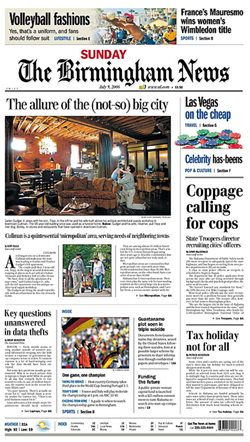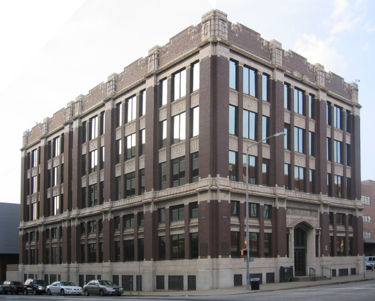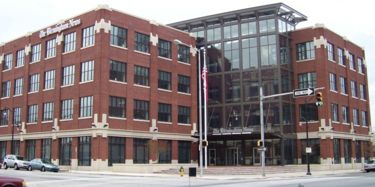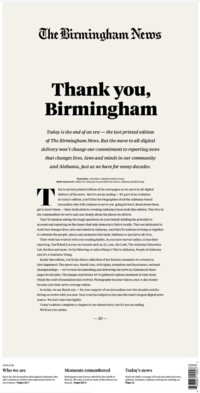Birmingham News: Difference between revisions
(→History: News as morning publication) |
|||
| (34 intermediate revisions by 4 users not shown) | |||
| Line 1: | Line 1: | ||
[[Image:Birmingham News front page 2006-07-09.png|right|thumb| | [[Image:Birmingham News front page 2006-07-09.png|right|thumb|275px|Cover of the July 9, 2006 ''Birmingham News'']] | ||
'''''The Birmingham News''''' | '''''The Birmingham News''''' was for decades the principal newspaper for the [[Birmingham]] area and the largest newspaper in [[Alabama]]. It was founded in [[1888]] by [[Rufus Rhodes]] and absorbed several rivals before being acquired in [[1955]] by Samuel Newhouse. It continued as a major outlet for Newhouse's Advance Publications until its Alabama publications were reorganized in [[2012]]. The newspaper continued to be distributed in print format until it published a final edition on Sunday [[February 26]], [[2023]], giving way to [[AL.com]]'s digital products. | ||
__NOTOC__ | __NOTOC__ | ||
== History == | == History == | ||
''The Birmingham News'' was launched on [[March 14]], [[1888]] by [[Rufus | ''The Birmingham News'' was launched on [[March 14]], [[1888]] by [[Rufus Rhodes]] as '''''The Evening News''''', a four-page paper with two reporters and $800 of operating capital working out of small, one-story building at [[1st Avenue North]] and [[21st Street North|21st Street]]. At the time, the city of Birmingham was only 17 years old, but was an already booming industrial city and a beacon of the "New South" still recovering from the aftermath of the [[Civil War]] and [[Reconstruction]]. Newspapers joined with industrial tycoons, academics and real-estate speculators in relentless boosterism of the new city. Rhodes was working as editor of the ''[[Birmingham Daily Herald|Daily Herald]]'' when he found his campaign for a viaduct spanning the "[[Railroad Reservation]]" dividing Birmingham's north and south opposed by his publisher. He determined to strike out on his own and launched the ''News'' with the slogan "Great is Birmingham and ''The News'' is its Prophet!" The "News Bridge" ([[21st Street Viaduct]]) was dedicated on [[July 4]], [[1891]], and deemed by his paper the "grandest of all municipal achievements of great and glorious Birmingham." | ||
The ''News'' circulation grew from 628 in 1888 to over 7,000 in [[1891]], when it became the largest daily in Alabama and won the contract to publish the General Laws of Alabama. In [[1889]], the name was changed from ''The Evening News'' to '''''The Daily News''''' and then, in [[1895]], ''The Birmingham News''. 1895 also marked the paper's move down the street to a three-story brick building at 213 21st Street North. The newspaper continued to grow, reaching a circulation of 17,000 in [[1909]]. | The ''News'' circulation grew from 628 in 1888 to over 7,000 in [[1891]], when it became the largest daily in Alabama and won the contract to publish the General Laws of Alabama. In [[1889]], the name was changed from ''The Evening News'' to '''''The Daily News''''' and then, in [[1895]], ''The Birmingham News''. 1895 also marked the paper's move down the street to a [[1895 Birmingham News building|three-story brick building]] at 213 [[21st Street North]]. The newspaper continued to grow, reaching a circulation of 17,000 in [[1909]]. | ||
Staunchly progressive in its political stance, the ''News'' supported a straight-ticket Democrat platform in election seasons and championed progressive causes such as [[prohibition]]. The ''News'' led the drumbeat for the "[[Greater Birmingham]]" movement to annex suburban communities. The successful campaign caused the population of the City of Birmingham to grow from 40,000 in 1900 to 138,685 in 1910, at which time Birmingham was the third largest city in the South. That same year, Rhodes died and was succeeded by his vice-president and general manager, [[Victor H. Hanson]]. | Staunchly progressive in its political stance, the ''News'' supported a straight-ticket Democrat platform in election seasons and championed progressive causes such as [[prohibition]]. The ''News'' led the drumbeat for the "[[Greater Birmingham]]" movement to annex suburban communities. The successful campaign caused the population of the City of Birmingham to grow from 40,000 in 1900 to 138,685 in 1910, at which time Birmingham was the third largest city in the South. That same year, Rhodes died and was succeeded by his vice-president and general manager, [[Victor H. Hanson]]. At the time, the paper's daily circulation was about 18,000. | ||
Hanson, only 33 years old, was already an accomplished newspaperman, having at age 11 founded the ''City Item'' in Macon, Georgia which he sold four years later for $2,500. Hanson helped modernize the newspaper's format, tone and operations | Hanson, only 33 years old, was already an accomplished newspaperman, having at age 11 founded the ''City Item'' in Macon, Georgia which he sold four years later for $2,500. Hanson helped modernize the newspaper's format, tone and operations. In [[1912]] the circulation of the ''News''{{'}} daily afternoon edition was reported at 22,499. Hanson added a Sunday edition, first printed on [[September 22]], [[1912]], to challenge Sunday ''[[Birmingham Age-Herald|Age-Herald]]''. Between [[1910]] and [[1914]] Hanson oversaw an increase in subscriptions to 40,000 and that year boldly claimed the title of "The South's Greatest Newspaper." | ||
[[Image:Birmingham News Building (1917).jpg|right|thumb| | [[Image:Birmingham News Building (1917).jpg|right|thumb|375px|The ''News''' 1917 building, demolished in 2007]] | ||
In [[1917]] the ''News'' moved to a [[Birmingham News building (1917)|new six-story office building]] on the corner of [[4th Avenue North]] and [[22nd Street North|22nd Street]] and | In [[1917]] the ''News'' moved to a [[Birmingham News building (1917)|new six-story office building]] on the corner of [[4th Avenue North]] and [[22nd Street North|22nd Street]] and three years later purchased the rival ''[[Birmingham Ledger]]'', increasing the size of its staff to 748 and its circulation to 60,000. In [[1920]] vice-president and editor [[Frank Glass]] retired. His 30 percent stake in the business was acquired by Hanson and two out-of-state newspaper publishers.<!--Owen Moon Jr and John Stewart Bryan--> | ||
An update to the ''News''' body type was made in the mid 1930s. The ''News'' and ''Age-Herald'' switched to Linotype's new "Corona" typeface in [[1941]]. | |||
From [[July 12]] to [[August 14]], [[1945]], publication of the ''News'', along with the ''[[Birmingham Post]]'' and ''Age-Herald'', was suspended due to a [[1945 printers' strike|printers' strike]]. | From [[July 12]] to [[August 14]], [[1945]], publication of the ''News'', along with the ''[[Birmingham Post]]'' and ''Age-Herald'', was suspended due to a [[1945 printers' strike|printers' strike]]. | ||
In [[1955]], Samuel Newhouse purchased the ''News'' and its subsidiaries ([[WAPI-AM]], [[WAFM-FM]], TV station [[WVTM|WABT]], Huntsville radio station WHBS-AM, | In [[1955]], Samuel Newhouse purchased the ''News'' and its subsidiaries ([[WAPI-AM]], [[WAFM-FM]], TV station [[WVTM|WABT]], Huntsville radio station WHBS-AM, ''The Huntsville Times'', and a freight company) for $18.7 million, a record at the time. Newhouse's publishing empire, now known as Advance Publications, still owns the newspaper and its related businesses. | ||
In [[1980]] the newspaper opened a new $32 million, 97,700 square-foot [[Birmingham News production building|printing and production building]] on the half-block north of its offices. In 1996, the News Corporation switched the publication times between the ''News'' and the ''Post-Herald'', making the ''News'' a morning paper. Both papers published a joint weekend edition, distributed on Saturdays. | |||
As of [[September 23]], [[2005]], when the afternoon ''[[Birmingham Post-Herald]]'' ceased publication, the ''News'' remained as the only daily newspaper serving the city. | |||
[[Image:Birmingham News Building 2007.jpg|left|thumb|375px|The 2006 Birmingham News building]] | |||
On [[August 10]], [[2006]] the ''News'' cut the ribbon on their [[2006 Birmingham News building|new headquarters building]] across 4th Avenue from their 1917 offices plant. The $25 million, 4-story, 110,000-square-foot brick and limestone building, designed by [[Williams-Blackstock Architects]], borrows several details from the older building and is dramatically bisected by a glass atrium. In [[2007]] the paper's owner received approval from Birmingham's [[Birmingham Design Review Committee|Design Review Committee]] to proceed with demolition of the older building to make way for a surface parking lot for employees. | |||
On [[July 25]] the ''News'' announced an offer of employee buyouts meant to save expenses as revenues dropped and expenses increased. Publisher [[Victor Hanson III]] retired in [[2009]] and was succeeded by [[Pam Siddall]]. Since October [[2011]], ''[[Birmingham magazine|Birmingham]]'' magazine has also been published by Advance. | |||
In June [[2012]] the ''News'' and its sister publications, ''The Huntsville Times'', ''The Mobile Press-Register'', and al.com, reorganized with two divisions, the [[Alabama Media Group]], led by [[Matt Sharp]], which was responsible for all content creation, and [[Advance Central Services Alabama]], led by Siddall, which was responsible for print and online distribution, as well as advertising sales, legal notices, subscriptions and other support services. | |||
As part of the reorganization, print newspapers were cut back to publishing three days a week. The ''News''' final daily edition was dated Sunday, [[September 30]], [[2012]], after which it began publishing only on Wednesdays, Fridays, and Sundays. The final print edition of the newspaper was distributed on [[February 26]], [[2023]]. | |||
==Honors== | ==Honors== | ||
In [[1991]], Ron Casey, Harold Jackson and Joey Kennedy received a Pulitzer Prize for Editorial Writing for their editorial campaign analyzing inequities in Alabama's tax system and proposing needed reforms. | In [[1991]], [[Ron Casey]], [[Harold Jackson]] and [[Joey Kennedy]] received a Pulitzer Prize for Editorial Writing for their editorial campaign analyzing inequities in Alabama's tax system and proposing needed reforms. | ||
In [[2006]] the ''News'' editorial staff were finalists for another Pulitzer for Editorial Writing for a series of editorials reversing the paper's longstanding support of the death penalty. That same year the paper won two Awards of Excellence from the Society for News Design for the paper's overall graphic layout. | In [[2006]] the ''News'' editorial staff were finalists for another Pulitzer for Editorial Writing for a series of editorials reversing the paper's longstanding support of the death penalty. That same year the paper won two Awards of Excellence from the Society for News Design for the paper's overall graphic layout. | ||
In [[2007]], reporter Brett Blackledge won the Pulitzer Prize for Investigative Reporting for his series of articles exposing corruption in Alabama's two-year college system. | In [[2007]], reporter [[Brett Blackledge]] won the Pulitzer Prize for Investigative Reporting for his series of articles exposing corruption in Alabama's two-year college system. Columnist [[John Archibald]] was awarded a Pulitzer Prize for commentary in [[2018]]. | ||
== | ==Circulation== | ||
[[File:2023-02-26 BNews final edition.png|right|thumb|200px|Front page of the final edition of ''The Birmingham News'']] | |||
Like most printed newspapers, the ''News'' average daily circulation dropped steeply in the 21st century. | |||
: 1888 - 628 | |||
: 1896 - 7,097 | |||
: 1909 - 17,000 | |||
: 1911 - 27,817 | |||
: 1921 - 60,000 | |||
: 1970 - 182,185 | |||
: 2004 - 157,225 | |||
: 2005 - 153,378 | |||
: 2006 - 150,174 | |||
: 2007 - 145,655 | |||
: 2008 - 140,438 | |||
: 2009 - 132,417 | |||
: 2010 - 113,810 | |||
: 2011 - 112,209 | |||
: 2012 - 103,729 | |||
: 2022 - 30,000 | |||
== References == | == References == | ||
* " | * Bishop, Clarence Etheridge Jr (195) "A Study of the First Fifty Years of the Birmingham News." M.A. thesis. University of Alabama | ||
* | * "[http://www.time.com/time/magazine/article/0,9171,711901,00.html On to Birmingham]" (December 12, 1955) ''TIME'' magazine | ||
* Jordan, Phillip (April 5, 2007) | * {{Birmingham News-1988}} | ||
* Fullman, Lynn Grisard (May 1992) "History of The Birmingham News." ''Old Birmingham'' magazine | |||
* Jordan, Phillip (April 5, 2007) "All the News that's fit to lose." ''Birmingham Weekly'' | |||
* DeButts, Jimmy (August 1, 2008) "Circulation drops at state's newspapers." {{BBJ}} | |||
* Beaujon, Andrew (May 24, 2012) "[http://www.poynter.org/latest-news/mediawire/175060/advance-cuts-daily-publication-of-its-three-alabama-papers/ Advance cuts daily publication of its three Alabama papers]" ''Poynter'' | |||
* Natta, André (June 6, 2012) "[http://bhamterminal.com/mybirmingham/2012/06/06/opinions-proposals-birmingham-news/ Reading into the Alabama Media Group plans]. The Terminal | |||
* Kent, Dawn (September 28, 2012) "[http://blog.al.com/businessnews/2012/09/birmingham_news_staffers_depar.html Many Birmingham News staffers depart as paper ceases daily publication, moves to 3 days a week]." {{BN}} | |||
* Hobbs, Delores Ann (November 7, 2013) "[http://www.encyclopediaofalabama.org/article/h-1388 The Birmingham News]" ''Encyclopedia of Alabama'' online - accessed September 18, 2019 | |||
* Bruell, Alexandra (November 3, 2022) "Alabama’s Three Largest Newspapers to Stop Printing Next Year." ''The Wall Street Journal'' | |||
* "See pages from final editions of Birmingham News, Huntsville Times and Mobile Press-Register." (February 25, 2023) {{AL}} | |||
[[Category:Birmingham News|*]] | [[Category:Birmingham News|*]] | ||
[[Category:1888 establishments]] | |||
[[Category:2023 disestablishments]] | |||
Latest revision as of 16:52, 16 January 2024
The Birmingham News was for decades the principal newspaper for the Birmingham area and the largest newspaper in Alabama. It was founded in 1888 by Rufus Rhodes and absorbed several rivals before being acquired in 1955 by Samuel Newhouse. It continued as a major outlet for Newhouse's Advance Publications until its Alabama publications were reorganized in 2012. The newspaper continued to be distributed in print format until it published a final edition on Sunday February 26, 2023, giving way to AL.com's digital products.
History
The Birmingham News was launched on March 14, 1888 by Rufus Rhodes as The Evening News, a four-page paper with two reporters and $800 of operating capital working out of small, one-story building at 1st Avenue North and 21st Street. At the time, the city of Birmingham was only 17 years old, but was an already booming industrial city and a beacon of the "New South" still recovering from the aftermath of the Civil War and Reconstruction. Newspapers joined with industrial tycoons, academics and real-estate speculators in relentless boosterism of the new city. Rhodes was working as editor of the Daily Herald when he found his campaign for a viaduct spanning the "Railroad Reservation" dividing Birmingham's north and south opposed by his publisher. He determined to strike out on his own and launched the News with the slogan "Great is Birmingham and The News is its Prophet!" The "News Bridge" (21st Street Viaduct) was dedicated on July 4, 1891, and deemed by his paper the "grandest of all municipal achievements of great and glorious Birmingham."
The News circulation grew from 628 in 1888 to over 7,000 in 1891, when it became the largest daily in Alabama and won the contract to publish the General Laws of Alabama. In 1889, the name was changed from The Evening News to The Daily News and then, in 1895, The Birmingham News. 1895 also marked the paper's move down the street to a three-story brick building at 213 21st Street North. The newspaper continued to grow, reaching a circulation of 17,000 in 1909.
Staunchly progressive in its political stance, the News supported a straight-ticket Democrat platform in election seasons and championed progressive causes such as prohibition. The News led the drumbeat for the "Greater Birmingham" movement to annex suburban communities. The successful campaign caused the population of the City of Birmingham to grow from 40,000 in 1900 to 138,685 in 1910, at which time Birmingham was the third largest city in the South. That same year, Rhodes died and was succeeded by his vice-president and general manager, Victor H. Hanson. At the time, the paper's daily circulation was about 18,000.
Hanson, only 33 years old, was already an accomplished newspaperman, having at age 11 founded the City Item in Macon, Georgia which he sold four years later for $2,500. Hanson helped modernize the newspaper's format, tone and operations. In 1912 the circulation of the News' daily afternoon edition was reported at 22,499. Hanson added a Sunday edition, first printed on September 22, 1912, to challenge Sunday Age-Herald. Between 1910 and 1914 Hanson oversaw an increase in subscriptions to 40,000 and that year boldly claimed the title of "The South's Greatest Newspaper."
In 1917 the News moved to a new six-story office building on the corner of 4th Avenue North and 22nd Street and three years later purchased the rival Birmingham Ledger, increasing the size of its staff to 748 and its circulation to 60,000. In 1920 vice-president and editor Frank Glass retired. His 30 percent stake in the business was acquired by Hanson and two out-of-state newspaper publishers.
An update to the News' body type was made in the mid 1930s. The News and Age-Herald switched to Linotype's new "Corona" typeface in 1941.
From July 12 to August 14, 1945, publication of the News, along with the Birmingham Post and Age-Herald, was suspended due to a printers' strike.
In 1955, Samuel Newhouse purchased the News and its subsidiaries (WAPI-AM, WAFM-FM, TV station WABT, Huntsville radio station WHBS-AM, The Huntsville Times, and a freight company) for $18.7 million, a record at the time. Newhouse's publishing empire, now known as Advance Publications, still owns the newspaper and its related businesses.
In 1980 the newspaper opened a new $32 million, 97,700 square-foot printing and production building on the half-block north of its offices. In 1996, the News Corporation switched the publication times between the News and the Post-Herald, making the News a morning paper. Both papers published a joint weekend edition, distributed on Saturdays.
As of September 23, 2005, when the afternoon Birmingham Post-Herald ceased publication, the News remained as the only daily newspaper serving the city.
On August 10, 2006 the News cut the ribbon on their new headquarters building across 4th Avenue from their 1917 offices plant. The $25 million, 4-story, 110,000-square-foot brick and limestone building, designed by Williams-Blackstock Architects, borrows several details from the older building and is dramatically bisected by a glass atrium. In 2007 the paper's owner received approval from Birmingham's Design Review Committee to proceed with demolition of the older building to make way for a surface parking lot for employees.
On July 25 the News announced an offer of employee buyouts meant to save expenses as revenues dropped and expenses increased. Publisher Victor Hanson III retired in 2009 and was succeeded by Pam Siddall. Since October 2011, Birmingham magazine has also been published by Advance.
In June 2012 the News and its sister publications, The Huntsville Times, The Mobile Press-Register, and al.com, reorganized with two divisions, the Alabama Media Group, led by Matt Sharp, which was responsible for all content creation, and Advance Central Services Alabama, led by Siddall, which was responsible for print and online distribution, as well as advertising sales, legal notices, subscriptions and other support services.
As part of the reorganization, print newspapers were cut back to publishing three days a week. The News' final daily edition was dated Sunday, September 30, 2012, after which it began publishing only on Wednesdays, Fridays, and Sundays. The final print edition of the newspaper was distributed on February 26, 2023.
Honors
In 1991, Ron Casey, Harold Jackson and Joey Kennedy received a Pulitzer Prize for Editorial Writing for their editorial campaign analyzing inequities in Alabama's tax system and proposing needed reforms.
In 2006 the News editorial staff were finalists for another Pulitzer for Editorial Writing for a series of editorials reversing the paper's longstanding support of the death penalty. That same year the paper won two Awards of Excellence from the Society for News Design for the paper's overall graphic layout.
In 2007, reporter Brett Blackledge won the Pulitzer Prize for Investigative Reporting for his series of articles exposing corruption in Alabama's two-year college system. Columnist John Archibald was awarded a Pulitzer Prize for commentary in 2018.
Circulation
Like most printed newspapers, the News average daily circulation dropped steeply in the 21st century.
- 1888 - 628
- 1896 - 7,097
- 1909 - 17,000
- 1911 - 27,817
- 1921 - 60,000
- 1970 - 182,185
- 2004 - 157,225
- 2005 - 153,378
- 2006 - 150,174
- 2007 - 145,655
- 2008 - 140,438
- 2009 - 132,417
- 2010 - 113,810
- 2011 - 112,209
- 2012 - 103,729
- 2022 - 30,000
References
- Bishop, Clarence Etheridge Jr (195) "A Study of the First Fifty Years of the Birmingham News." M.A. thesis. University of Alabama
- "On to Birmingham" (December 12, 1955) TIME magazine
- Jones, Emily, ed. (1988). The Birmingham News: Our First 100 Years. Birmingham, AL: The Birmingham News Company.
- Fullman, Lynn Grisard (May 1992) "History of The Birmingham News." Old Birmingham magazine
- Jordan, Phillip (April 5, 2007) "All the News that's fit to lose." Birmingham Weekly
- DeButts, Jimmy (August 1, 2008) "Circulation drops at state's newspapers." Birmingham Business Journal
- Beaujon, Andrew (May 24, 2012) "Advance cuts daily publication of its three Alabama papers" Poynter
- Natta, André (June 6, 2012) "Reading into the Alabama Media Group plans. The Terminal
- Kent, Dawn (September 28, 2012) "Many Birmingham News staffers depart as paper ceases daily publication, moves to 3 days a week." The Birmingham News
- Hobbs, Delores Ann (November 7, 2013) "The Birmingham News" Encyclopedia of Alabama online - accessed September 18, 2019
- Bruell, Alexandra (November 3, 2022) "Alabama’s Three Largest Newspapers to Stop Printing Next Year." The Wall Street Journal
- "See pages from final editions of Birmingham News, Huntsville Times and Mobile Press-Register." (February 25, 2023) AL.com



